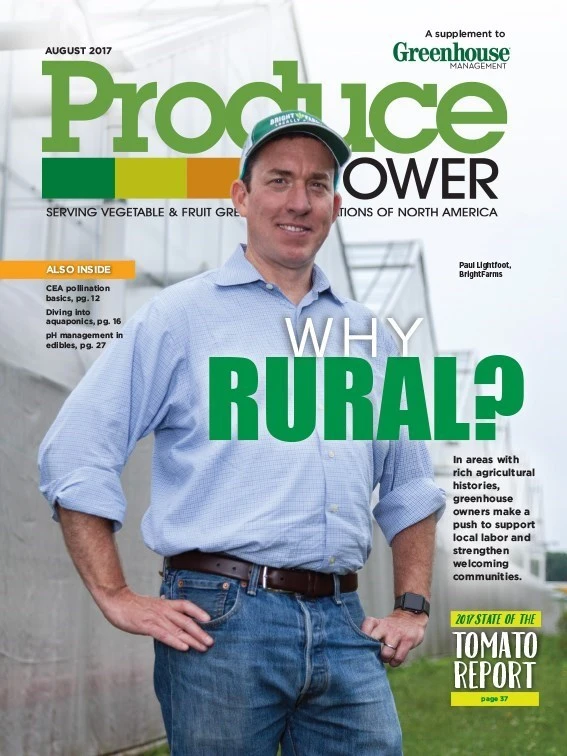
We’re kicking off this year’s third annual State of the Tomato Report with our latest research, which shows that tomatoes are still the top crop for produce growers; 83% of Produce Grower readers are producing finished tomatoes or tomato transplants in a controlled environment. This year, growers, researchers and consumers alike are honed in on taste, deemed to be the most important attribute in a tomato crop by our grower respondents, an area of focus for researchers, and a desired trait for consumers who won’t settle for less.
On page 44, you can read about one of these growers, Huron Produce, that’s focused on sustainability as they produce the Suntastic brand of tomatoes.
If you’re among the 83% already growing tomatoes, or the 17% who may be interested in starting, you won’t want to miss University of Florida assistant professor of horticulture Celina Gómez’ seven greenhouse tomato crop management tips, starting on page 49.
Leslie Halleck shares her perspective on her favorite tomatoes, and how to connect with tomato-loving consumers (or those who despise them) on page 51. Two researchers at the Vineland Research and Innovation Centre have been on the quest for the tastiest tomato, and discuss their latest consumer research and breeding projects on page 54. Lastly, if you’re looking for a new tomato to try in your greenhouse, check out the varieties on page 55.
Growers weigh in




Types of tomatoes

Tomatoes are, by far, the most common produce crop being grown in controlled environments, and consumers are buying them regularly. U.S. consumers ate about 21.3 pounds of fresh tomatoes in 2016, up from about 20.5 in 2014 and 2015, according to the USDA-ERS 2016 Vegetables and Pulses Yearbook; this is the highest consumption by weight of any of the fresh products surveyed, besides potatoes. The next most popular crops are hot or sweet peppers, grown by 73% of growers, and cucumbers, grown by 65%.

The most popular tomatoes are the beefsteak varieties — about 69% of growers produce them. The next most popular tomatoes were cherry varieties (69% produce them) and heirlooms (62%). Overall, the average greenhouse is filled with about 25% beefsteak tomatoes, 20% heirloom tomatoes, 16% slicers, 13% cherry tomatoes, and about a fourth of it is made up of other varieties such as sauce, on-the-vine, grape and grafted plants.

This year, we’re seeing a 4% uptick in growers producing indeterminate tomatoes, and a slight increase in determinate tomato production. However, fewer growers are producing both determinate and indeterminate, down about 6-7% compared to the previous two years.

Perhaps unsurprisingly, flavor far outranked any other attribute for tomato crops. If a tomato doesn’t taste good, consumers won’t buy it again, and growers may end up with an unsellable crop. However, if the tastiest of tomatoes produces a very low yield or isn’t particularly disease resistant, growers may hesitate to grow it.

For more insights on what makes a tomato variety great, turn to page 51 for Leslie Halleck’s perspective on “restaurant tomatoes,” and page 53 to learn about the consumer research and breeding being done by the Vineland Research and Innovation Centre.
Production

This year, 39% percent of respondents said they would increase their finished tomato production in 2017, while 30% said their tomato transplants would see an increase. Overall, those produce growers anticipating an increase in either finished or transplant production, or both, totaled 49% this year, compared to 39% last year.

One of the advantages of growing produce in a controlled environment is the ability to sell year-round, even in harsher climates. This year, we asked growers if they’re able to obtain different price points in different seasons, and nearly 40% said that they do. Presumably, growers are able to command a higher price when supply is low, such as during the winter months.

Explore the August 2017 Issue
Check out more from this issue and find your next story to read.
Latest from Produce Grower
- WUR extends Gerben Messelink’s professorship in biological pest control in partnership with Biobest and Interpolis
- Closing the loop
- The Growth Industry Episode 8: From NFL guard to expert gardener with Chuck Hutchison
- Raise a glass (bottle)
- From farm kid to Ph.D.
- Do consumers trust produce growers?
- The modern grocery shopper
- Beyond a burst of optimism





